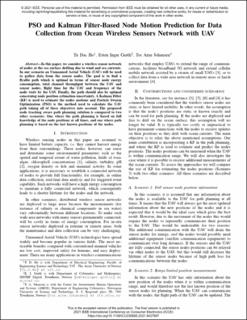| dc.contributor.author | Ho, Tu Dac | |
| dc.contributor.author | Grøtli, Esten Ingar | |
| dc.contributor.author | Johansen, Tor Arne | |
| dc.date.accessioned | 2022-05-11T08:27:09Z | |
| dc.date.available | 2022-05-11T08:27:09Z | |
| dc.date.created | 2022-02-01T11:41:43Z | |
| dc.date.issued | 2021 | |
| dc.identifier.citation | IEEE International Symposium on Consumer Electronics. 2021. | en_US |
| dc.identifier.issn | 2158-3994 | |
| dc.identifier.uri | https://hdl.handle.net/11250/2995200 | |
| dc.description.abstract | In this paper, we consider a wireless sensor network of nodes at the sea surface drifting due to wind and sea currents. In our scenario an Unmanned Aerial Vehicle (UAV) will be used to gather data from the sensor nodes. The goal is to find a flyable path which is optimal in terms of sensor node energy consumption, total channel throughput between the UAV and sensor nodes, flight time for the UAV and frequency of the node visits by the UAV. Finally, the path should also be optimal concerning node position estimation uncertainty. A Kalman Filter (KF) is used to estimate the nodes motions and Particle Swarm Optimization (PSO) is the method used to calculate the UAV path taking all of these objectives into account. The proposed node tracking aware path planning solution is compared to two other scenarios: One where the path planning is based on full knowledge of the node positions at all times, and one where path planning is based on the last known positions of the nodes. | en_US |
| dc.language.iso | eng | en_US |
| dc.publisher | Institute of Electrical and Electronics Engineers (IEEE) | en_US |
| dc.subject | Energy consumption | en_US |
| dc.subject | Wireless sensor networks | en_US |
| dc.subject | Uncertainty | en_US |
| dc.subject | Tracking | en_US |
| dc.subject | Sea measurements | en_US |
| dc.subject | Data collection | en_US |
| dc.subject | Unmanned aerial vehicles | en_US |
| dc.title | PSO and Kalman Filter-Based Node Motion Prediction for Data Collection from Ocean Wireless Sensors Network with UAV | en_US |
| dc.type | Peer reviewed | en_US |
| dc.type | Journal article | en_US |
| dc.description.version | acceptedVersion | en_US |
| dc.rights.holder | © 2021 IEEE. Personal use of this material is permitted. Permission from IEEE must be obtained for all other uses, in any current or future media, including reprinting/republishing this material for advertising or promotional purposes, creating new collective works, for resale or redistribution to servers or lists, or reuse of any copyrighted component of this work in other works. | en_US |
| dc.source.pagenumber | 7 | en_US |
| dc.source.journal | IEEE International Symposium on Consumer Electronics | en_US |
| dc.identifier.doi | 10.1109/ICCE50685.2021.9427697 | |
| dc.identifier.cristin | 1996196 | |
| dc.relation.project | Norges forskningsråd: 223254 | en_US |
| cristin.ispublished | true | |
| cristin.fulltext | preprint | |
| cristin.qualitycode | 1 | |
